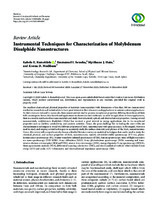| dc.description.abstract | The excellent chemical and physical properties of materials (nanomaterials) with dimensions of less than 100 nm (nanometers) resulted in researchers and industrialists to have great interest in their discovery and applications in various systems/applications. As their sizes are reduced to nanoscale, these nanomaterials tend to possess exceptional properties differing from those of their bulk counterparts; hence, they have found applications in electronics and medicines. In order to apply them in those applications, there is a need to synthesise these nanomaterials and study their structural, optical, and electrochemical properties. Among several nanomaterials, molybdenum disulphide (MoS2) has received a great interest in energy applications due to its exceptional properties such as stability, conductivity, and catalytic activities. Hence, the great challenge lies in finding the state-of-the-art characterization techniques to reveal the different properties of MoS2 nanostructures with great accuracy. In this regard, there is a need to study and employ several techniques to accurately study the surface chemistry and physics of the MoS2 nanostructures. Hence, this review will comprehensively discuss a detailed literature survey on analytical techniques that can be used to study the chemical, physical, and surface properties of MoS2 nanostructures, namely, ultraviolet-visible spectroscopy (UV-vis), photoluminescence spectroscopy (PL), Fourier transform infrared spectroscopy (FTIR), Raman spectroscopy, time-of-flight secondary ion mass spectroscopy (TOF-SIMS), X-ray diffraction (XRD), X-ray photoelectron spectroscopy (XPS), scanning and transmission electron microscopies (SEM and TEM), atomic force microscopy (AFM), energy dispersive X-ray spectroscopy (EDS/X), thermogravimetric analysis (TGA), differential scanning calorimetry (DSC), and electroanalytical methods which include linear sweep (LSV) and cyclic (CV) voltammetry and electrochemical impedance spectroscopy (EIS). | en_US |

